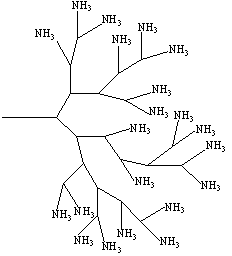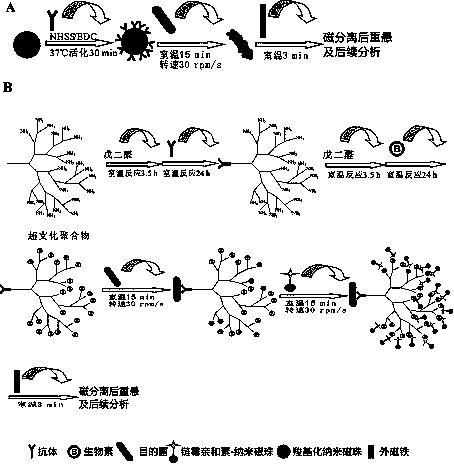Fast magnetic separation method of mycobacterium tuberculosis (MT)
A technology of Mycobacterium tuberculosis and magnetic separation, applied in the biological field, can solve the problems of separation failure, high concentration of bacteria, cell rupture, etc., to increase the chance of contact, stabilize the reaction solution, and improve the capture efficiency.
- Summary
- Abstract
- Description
- Claims
- Application Information
AI Technical Summary
Problems solved by technology
Method used
Image
Examples
Embodiment 1
[0030] 1. The hyperbranched polymer-antibody complex is prepared according to the following steps:
[0031] (1) Weigh 0.5 mg hyperbranched polymer aminated hyperbranched polyamidoamine modified with amino groups at the end, suspend in 4 mL phosphate buffer (PBS, 0.01 mol / L, pH 8.0), stir and add 25 % glutaraldehyde aqueous solution 545 μL, so that the final concentration of glutaraldehyde was 3%. React at room temperature for 3.5 h at a rotating speed of 150 r / min on a shaker;
[0032] (2) Add Mycobacterium tuberculosis to the above solution MT Specific antibody 12 mg, so that the final concentration reached about 3 mg / mL. React at room temperature for 24 hours at a shaking table of 150 r / min;
[0033] (3) The above solution was spin-dried under reduced pressure, dissolved in deionized water, and dialyzed in PBS and deionized water for 1 day; after the dialysis, the obtained solution was freeze-dried.
[0034] 2. The long-chain biotin-hyperbranched polymer-antibody comple...
Embodiment 2
[0040] Example 2 Enrichment effect experiment
[0041] (1) Take 1 mL of concentration as 10 4 cfu / mL Mycobacterium tuberculosis in a 1.5 mL sterile centrifuge tube, centrifuge at 12000 rpm for 5 min, discard the supernatant, and resuspend with an equal volume of sterile PBS solution.
[0042] (2) Enrichment and capture: Set up the technical solution group of the present invention (hyperbranched polymer group co-modified with Mycobacterium tuberculosis antibody and long-chain biotin), nano magnetic beads group modified with Mycobacterium tuberculosis specific antibody, tuberculosis fraction Mycobacterium-specific antibody-modified micron magnetic beads group enriches target bacteria.
[0043] (3) After magnetic separation, the supernatant was poured into a sterile centrifuge tube, and the isolated immunomagnetic beads that captured Mycobacterium tuberculosis were washed twice with PBST, mixed evenly, and reconstituted with 1 mL of sterile PBS solution. Suspend the immunomagn...
Embodiment 3
[0057] Example 3 Enrichment capture experiment
[0058] Conventional magnetic stand separation time is 30min, and all the other are with embodiment 2.
[0059] The catch rate of each group is as follows:
[0060] Capture Efficiency of Mycobacterium Tuberculosis-Specific Antibody Modified Micro Bead Sets Capture efficiency of nanomagnetic bead sets modified with specific antibodies against Mycobacterium tuberculosis Capture efficiency of hyperbranched polymer groups co-modified with Mycobacterium tuberculosis antibody and long-chain biotin 51.3% 36.4% 88.9%
PUM
| Property | Measurement | Unit |
|---|---|---|
| particle diameter | aaaaa | aaaaa |
| particle diameter | aaaaa | aaaaa |
Abstract
Description
Claims
Application Information
 Login to View More
Login to View More - R&D
- Intellectual Property
- Life Sciences
- Materials
- Tech Scout
- Unparalleled Data Quality
- Higher Quality Content
- 60% Fewer Hallucinations
Browse by: Latest US Patents, China's latest patents, Technical Efficacy Thesaurus, Application Domain, Technology Topic, Popular Technical Reports.
© 2025 PatSnap. All rights reserved.Legal|Privacy policy|Modern Slavery Act Transparency Statement|Sitemap|About US| Contact US: help@patsnap.com


